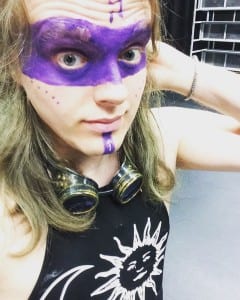Pictured above: final makeup test taken on the day of the performance.
A reflection on yesterday’s performamces.
Over the allotted time I had in the space, I chose to perform three times as initially I had thought that through audience interaction I would have several different pieces. However due to time constraints I had to modify this significantly and ended up with the same story but performed like two versions of the same piece. Herein, I give a brief reflection of the day’s pieces covering what I thought went well, what did not go so well and ending with what I think would have improved it.
Get in:
During the get in I rebuilt the cardboard hut, which I decorated with little markings and runes to add a lived in effect. If I could have done it differently, I would have made a sturdier frame as the hut would often fall apart during rehersals. I added small button lamps which cast cones of light int he mist to allude to a larger world beyond that of our meeting place. If I could have had more time I would have liked tohave decorated the space more and made it less naturalistic and more surreal. The costume choice was used to attempt to create a sense of “otherness” which I feel was succsessful.
First Performance:
I feel that the first performance went well. I could have been clearer with my intentions and how the piece would function as audience interaction was required by building more on my influence taken from Tim Crouch and his gentler approach to his audience when he called upon them to interact. I do feel that the atmosphere I was hoping to create went together well in the end however, as the story was the first option taken it allowed me to experiment with what worked within the story to an audience for the first time.
Second performance:
This performance was the one that was graded. I was able to interact with the audience this time in a way that I had expected and I feel that the story had more impact this time around. I do feel however in this version I wasn’t clear enough about the way that Annie Sprinkle’s piece concerning ecosexual weddings (Sexecology,2018) influenced the vow at the end that I make the audience promise. In that they will go back to “their time” and protect the earth.
Third performance:
With this performance I feel that it went better than the second as I felt the audience participation to be stronger here with people taking a drink with me for the first time. Also for the first time the audience asked to see their futures first. I do feel however that by this point I was tired and my energy had been somewhat lacking. But on the whole, I feel this went well.
Overall:
I feel that if I had completed the script sooner, ideally in April, and been more confident with the idea as I will admit I had felt uncertain of my methodology and setting, I would have been much more satisfied with how the final piece turned out. I am by no means saying I wasn’t satisfied with the piece, quite the contrary, I’m happy with how it turned out and how the audiences responded to a theatrical space set out with minimal conventions to create the feeling of a “lived in” apocalyptic world.
Sexecology (2018) Ecosex weddings. Available from http://sexecology.org/ecosex-weddings/ [accessed 23 may 2018].

![IMG_6122[1]](https://soloperformancebrewerd.blogs.lincoln.ac.uk/files/2018/05/IMG_61221-300x225.jpg)